Intel Core i7 4960X (Ivy Bridge E) Review
by Anand Lal Shimpi on September 3, 2013 4:10 AM EST- Posted in
- CPUs
- Intel
- Ivy Bridge
- Ivy Bridge-E
Visual Studio Compile
Our compile test is back and better than ever. With a much larger and faster SSD (Samsung SSD 830, 512GB), we're able to get more consistent compile times between runs. We're now using Visual Studio 2012 to compile Mozilla's Firefox project. The compile is multithreaded however there are periods of serial operation where performance is bound by the speed of a single core. The end result is a benchmark that stresses both single and multithreaded performance. Compile times are reported in minutes elapsed.
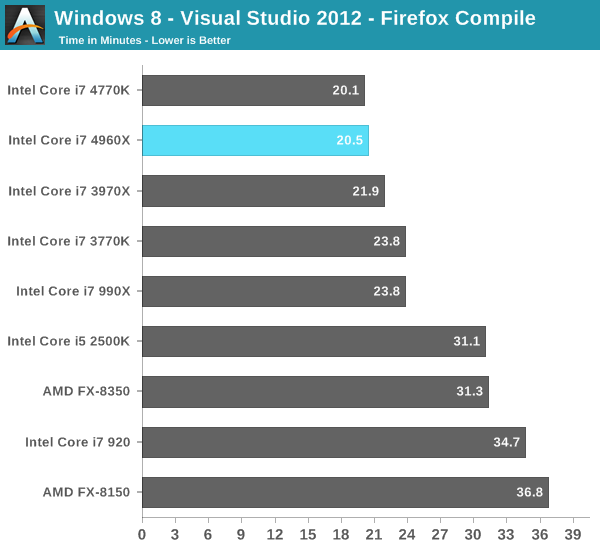
It's clear that IVB-E holds the advantage over Haswell when faced with heavily threaded workloads, but what about those workloads that are a good mix of both light and heavily threaded tasks? A medium-threaded workload if you will. It turns out our Firefox compile test is just that. Haswell's architectural improvements seem to do wonders for this test (under OS X as well), giving the 4770K a 16% lower compile time than Ivy Bridge. IVB-E on the other hand throws more cores at the problem, effectively equaling Haswell's performance but not exceeding it. In this case, if the rest of your applications are better threaded/demand more cores then IVB-E is the right solution for you. If, however, building Visual Studio projects is the most thread heavy thing you do then Haswell is a better option.
Photoshop
To measure performance under Photoshop CS4 we turn to the Retouch Artists’ Speed Test. The test does basic photo editing; there are a couple of color space conversions, many layer creations, color curve adjustment, image and canvas size adjustment, unsharp mask, and finally a gaussian blur performed on the entire image.
Time is reported in seconds and the lower numbers mean better performance. The test is multithreaded.
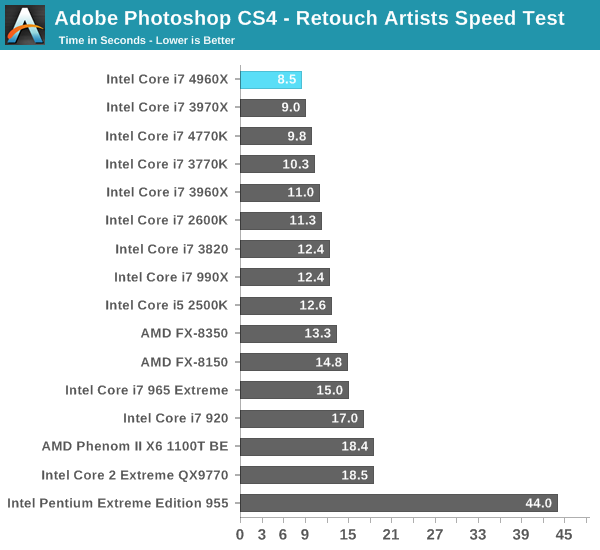
Our Photoshop test provides another example of an application with both lightly and heavily threaded behaviors. In this case, our Photoshop test favors the latter as the 4960X manages a 13% performance advantage over the 4770K. Once again the IVB-E advantage over SNB-E is around 5%.
File Compression/Decompression
The 7-zip benchmark is a CPU bound multithreaded integer workload that looks at 7-zip compression/decompression algorithms where the IO subsystem is removed from the equation:
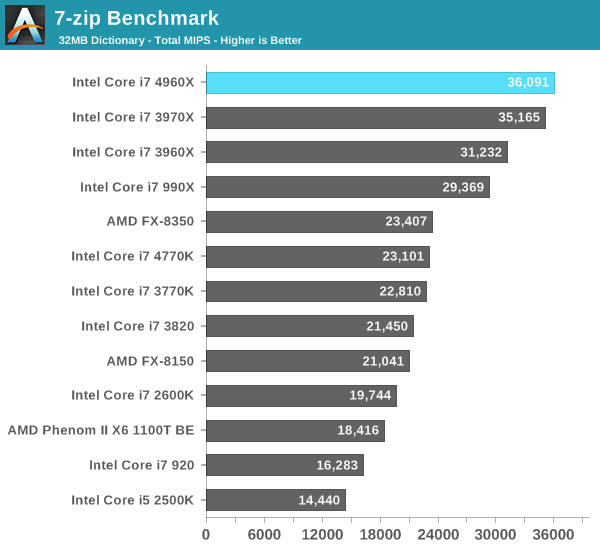
In its biggest advantage so far, the 4960X outperforms the 4770K by 56% in the 7-zip test. The IVB-E performance advantage compared to SNB-E shrinks to under 3% here. Heavily threaded integer workloads are also well suited for AMD's FX architecture. Here the FX-8350 is able to equal Haswell's performance.
Next up is our old Par2 test. Par2 is an application used for reconstructing downloaded archives. It can generate parity data from a given archive and later use it to recover the archive. Chuchusoft took the source code of par2cmdline 0.4 and parallelized it using Intel’s Threading Building Blocks 2.1. The result is a version of par2cmdline that can spawn multiple threads to repair par2 archives. For this test we took a 708MB archive, corrupted nearly 60MB of it, and used the multithreaded par2cmdline to recover it. The scores reported are the repair and recover time in seconds.
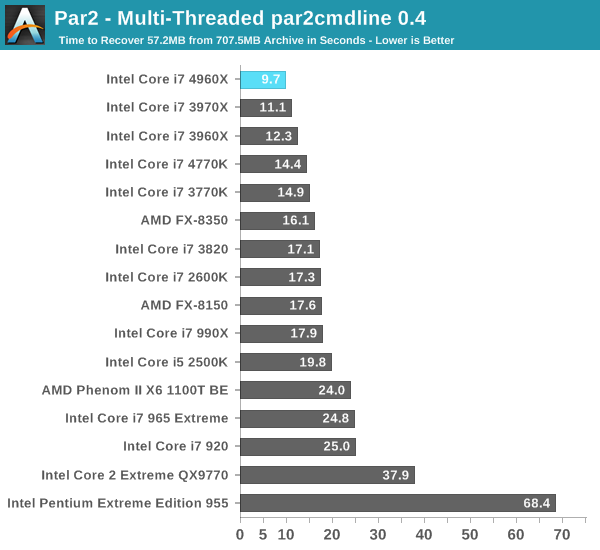
Here's another heavily threaded workload that does very well on the 4960X. We also see a rare situation where IVB-E increases performance over SNB-E by more than 10%.
Excel - Heavy Math
In our final CPU centric test we're running a monte carlo simulation on a large Excel spreadsheet. The process is well threaded.
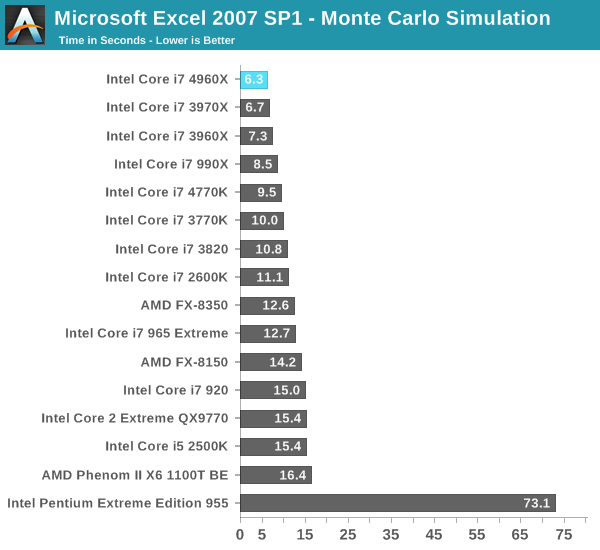
With 50% more cores, the 4960X delivers 33% better performance than the 4770K. If running multithreaded math workloads is up your alley, there's no alternative to the 6-core extreme edition parts.










120 Comments
View All Comments
1Angelreloaded - Tuesday, September 3, 2013 - link
Can you have a comparison chart please for the 4770k, E5-8core Xenon, 4960X, with benchmarks included. This kind of makes little sense to me X-79 was behind on feature sets like full SATA3 when in reality a lot of these boards will be used as workstation/normal/gaming computers, performance on those boards tends to suffer because lack there of native support. Instead 3rd party chips are used to add extra features which have significant drawbacks. I understand using the socket for 2 gen in order to extend life of boards however 1336 and the next leap to haswell should have been taken, making a board last 2 years with the prime features that defined that generation. This just seams like intel is ignoring its higher end market due to lack of competition out there.sabarjp - Tuesday, September 3, 2013 - link
Kind of depressing that 3 years of technology only took the compile of Firefox from 23 minutes to 20 minutes. The high-end isn't looking so high these days.dgingeri - Tuesday, September 3, 2013 - link
So where's the 4820k review? I don't care much about more than 4 cores, but I need more I/O than Haswell offers. (crappy motherboards that offer either 8/4/4 or 8/8/2 are just unacceptable.) I'd like to know how the 4820k overclocks and handles I/O from dual and triple SLi/Crossfire.Eidigean - Tuesday, September 3, 2013 - link
Visual Studio unfortunately does not compile in parallel the way you might think. In a solution you may have multiple projects. If one project depends on four other projects, those four will be compiled in parallel; one project per thread. Once the four dependencies are built, it can build the fifth; however, that last project will be built single-threaded.Xcode and native Android projects (with gcc) can actually build multiple files from one project in parallel. On an i7 with hyperthreading, all eight logical processors can build up to eight files simultaneously. This scales with more cores very nicely.
In summary, VS builds multiple projects from one solution in parallel, while gcc builds multiple files from one project in parallel; the latter of which is much faster.
I'm curious now to see the build times of Firefox for Mac on a rMBP with an i7. Eagerly waiting for a 12 core Mac Pro with 24 logical processors.
BrightCandle - Tuesday, September 3, 2013 - link
Visual Studio is a very poor parallel compilation test. GCC with make -p can really utilise a lot more cores but its not very Windows like to use GCC (although I suspect many developers do that).I haven't found many Java builds doing well on multiple cores, and neither Scala. Its the unit tests where I get the cores going, I can saturate hundreds of cores with unit tests if I had them, and since I run them in the background on every change I certainly do get a lot of usage out of the extra cores. But a clean compile is not one of those cases where I see any benefit from the 6 cores. Of course I would hope these days we don't do that very often.
althaz - Tuesday, September 3, 2013 - link
It is a poor parallel test, but it is a fantastic real-world test for a lot of devs.madmilk - Tuesday, September 3, 2013 - link
About 25 minutes here on an 2.6GHz/16GB rMBP. Pretty much as expected for quad Ivy Bridge.bminor13 - Tuesday, September 3, 2013 - link
Parallel file-level compilation is possible in VS2010 and up with the /MP project switch. This is not enabled by default I believe for compatibility reasons.BSMonitor - Tuesday, September 3, 2013 - link
A Haswell-E will most likely bring a different pin-count, correct?? So this X79 is a dead end platform any way you look at it. Buying the Quad IVB-E makes almost no sense whatsoever.Casper42 - Tuesday, September 3, 2013 - link
Most Intel chips use a Tick Tock release cycle. Tick Tock Tick Tock Tick Tock etcTick is an Incremental upgrade. Same socket and largely same design, but reduced lithography (32nm down to 22nm for example). Sometimes new Instructions but often not.
Tock is an Overhaul upgrade. Uses same Lithography as the previous gen, but is a new internal architecture, often a new Socket, and where most new Instruction sets show up.
Then you get another Tick.
Core 2/Conroe was a Tock and was 65nm
Core 2/Penryn was a Tick and was 45nm
Core iX/Nehalem was a Tock and was 45nm
Core iX/Westmere was a Tick and was 32nm
Core iX/Sandy Br was a Tock and was 32nm
Core iX/Ivy Bridge is a Tick and is 22nm
Core iX/Haswell is a Tock and is 22nm
So to say that X79 is a dead platform should not really be a shock to anyone. They got Sandy and Ivy out of it. Thats 1 Tock and 1 Tick and now its time to move on. They do this exact same thing in the 2P Server market where people spend $10K or more per server. The fact of the matter is the server market has already pretty much learned. Don't bother upgrading that server/machine, just ride it for 3-4 years and then replace it completely. SATA, Memory and CPUs have all changed enough by then you want to reset everything anyway.